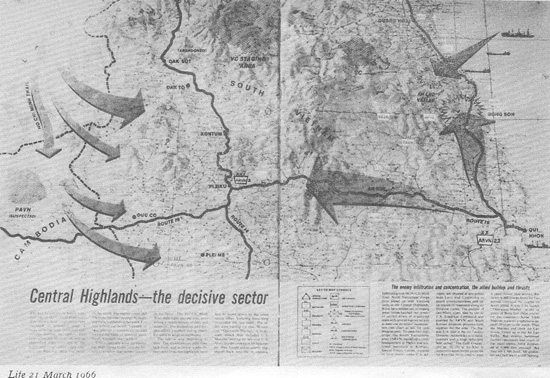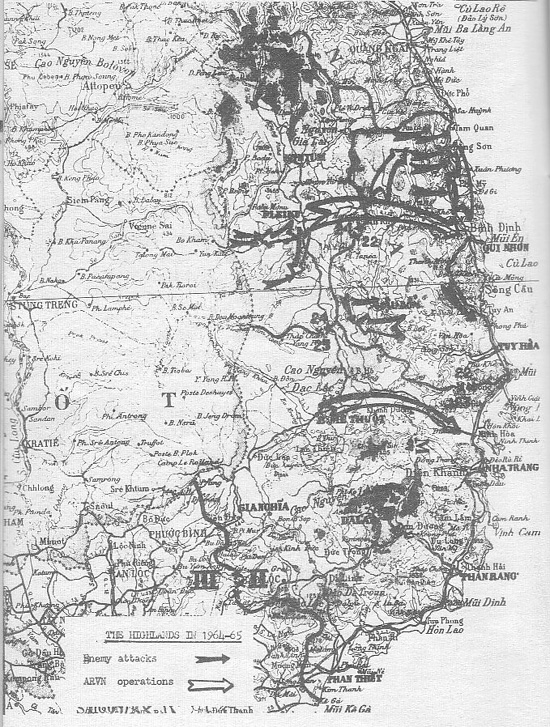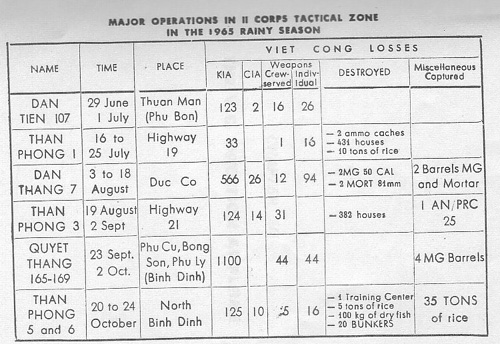
1964-1965
The Same War with a Big Difference
Now the Regulars
The above statement, from a French military commander who himself has experienced the fierce vicissitudes of deadly combat and guerrilla warfare, could be used to best summarize what happened in the Central Highlands at the beginning of 1964.

Instead of separate teams of cadres sent to South Viet Nam to activate units on the spot, whole regiments were infiltrated through the Ho Chi Minh trail and larger supplies of weapons and equipment stealthily conveyed by sea to secret bases. On 16 February 1965, a VC ship was sunk at Vung Ro (Phu Yen) by the Vietnamese Navy and numerous caches of arms discovered at Da Bia by the 23rd ARVN Division (same province): more than 2000 crew-served and individual weapons as well as 73 tons of ammunitions were captured.
Early 1965, the Headquarters of the 325th NVA Division made their apparition in the Highlands and assumed the control and coordination of all enemy efforts in the area. The shift to positional warfare and war of movement began.
The first campaign (from January to May) aimed at objectives similar to those of the "Winter-Summer Campaign" in 1954: to paralyze Highway 19 and control the area North of Binh Dinh, in order to isolate the northern part of the Highlands (Kontum and Pleiku provinces) from the coast. They did succeed, in fact, in their military actions but it was rather their propaganda and psychological warfare which brought the most serious impact upon the friendly situation, especially when by June, Highways 21 and 19Bis also fell under their control. Without exaggerations, it could be said that by the first days of July, the three northern provinces in the Highlands - Pleiku, Kontum and Phu Bon - had degenerated into chaos and it seemed that, barring a miracle, nothing could appease the panic among the local population.
Challenge and Response
In this deplorable conjuncture, there remains only one certainty: the Highlands were to be defended, at any cost, unless a sinister decision had been made to give up fighting and surrender. The disaster in 1954 were never to be repeated.

This determination of the Armed Forces of the Republic of Vietnam was expressed in the following concept and decision taken by Second Army Corps Commander:
Within two months, continuous operations were conducted. The most important were:
Met by such a strong determination and reaction, the enemy was compelled to withdraw after having in their turn suffered heavy losses. For the first time in several months, the situation in the Highlands relatively improved during the month of September. Two Fulro rebel battalions, discouraged by the VC recession also loft their hideouts in the jungle North of Darlac to surrender on 8 September. The tension which had oppressed the population thus far eased down as the rainy season was nearing its end.
Back in their retreat deep in the mountains and jungle, the VC ruminated their plan and assuredly, pondered over their failure in the rainy season.
Successively, their two campaigns since the beginning of the year had rather brought reverse effects and results.

The expansion and seizure of terrain which had been so easy to achieve in 1954 could not take place again, unless the ARVN vital forces were destroyed. Such a destruction could neither take place unless large campaigns were conducted because previous separate attacks had allowed the ARVN to get out of their difficulties by a methodic and appropriate maneuver of forces, although they had only limited capabilities.
The remedy thus consisted of the following requirements:
(*) Literal translation of the so-called "nhất điểm lưỡng diện" tactics of the VC in the offense. The expression simply means either "one main effort and two secondary efforts" or "one main attack and two diversionary attacks".
Major General Vinh Loc
Colonel Hieu, ghostwriter
(Why Pleime - April 1966)
- A Few Things You Should Know about Pleime-Iadrang Campaign
- "Victory at Pleime" ?
- Tactical Moves in Pleime Battle
- The Two Principals Players Of Pleime Chess Game
- Pleime Battle's Diary
- Why Pleime
- Battle of Pleime
- Plei Me Battle
- 1st US Cavalry Division Gives Support in the Battle at Plei Me
- Seven Days of Zap
- Pleime Campaign
- Battle of Duc Co
- American Perspective of Pleime Battle
- The Truth about the Pleime Battle
- Crushing the American Troops in Central Highlands
- Crushing the American Troops in Western Highlands or in Danang?
- NVA 66th Regiment in Pleime-Ia Drang Campaign
- The Fog of War: The Vietnamese View of the Ia Drang Battle
- What Really Happened at Ia Drang Battle
- The Political Commissar at the First Battle Against the Americans in Central Highlands
- The Unfolding of Strategic and Tactical Moves of Pleime Campaign
- Reviewing "Why Pleime"
- CIDG in Camp Defense (Plei Me)
- Things the VC Don't Want People To Know at Pleime Battle
- Pleime Through New York Times' View
- Ia Drang Valley Battle? Which One?
- General Schwarzkopf's Naïveté In Ia Drang Battle
- LZ X-Ray After Action Report - LTC Hal Moore and Colonel Hieu
- NVA Colonel Ha Vi Tung at Pleime-LZ Xray-LZ Albany
- Pleime Battle Viewed From G3/I Field Force Vietnam
- Than Phong 7 Operation Viewed From G3/I Field Force Vietnam
- Pleiku Campaign
- Pleime Campaign and Pleiku Campaign